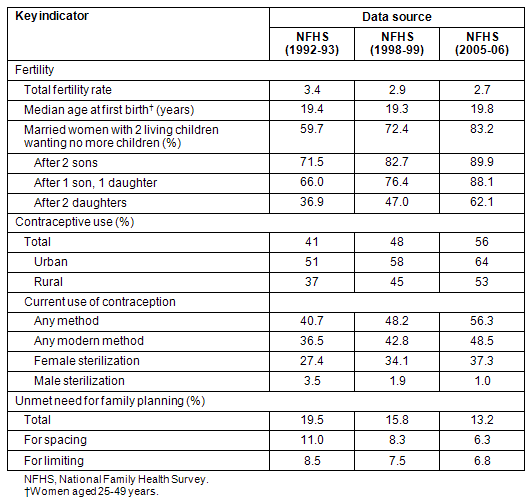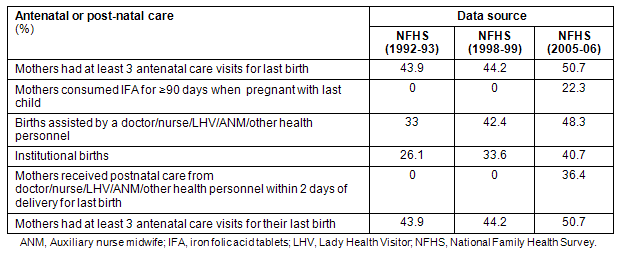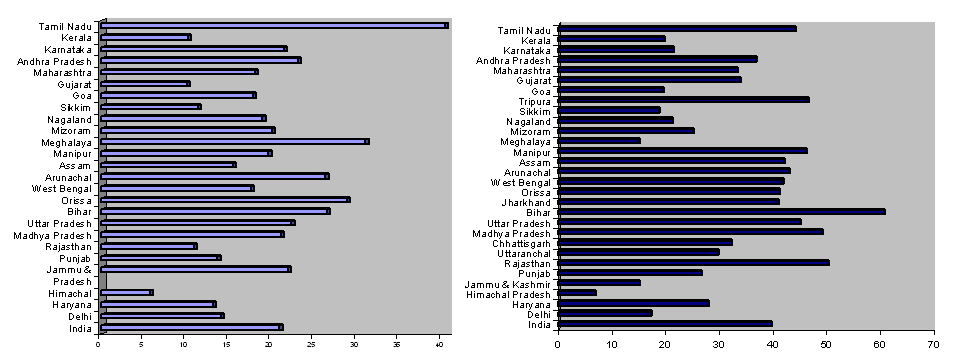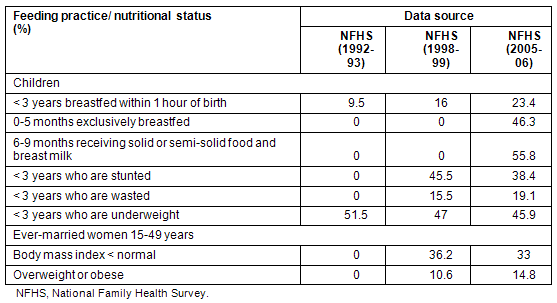Introduction
You can tell the condition of a nation by looking at the status of its women. Jawaharlal Nehru
India has 16% of the world's population but only 2.4% of its landmass, resulting in great pressures for resources. It is a country where 70% of the population resides in a rural area and males significantly outnumber females, an imbalance that has increased over time. The typical female advantage in life expectancy is not seen in India and this suggests there are systematic problems in women's health care.
Indian women have high mortality rates, particularly during childhood and in their reproductive years. India's maternal mortality rates in rural areas are among the world's highest. From a global perspective, India accounts for 19% of all live births and 27% of all maternal deaths. The health of Indian women is intrinsically linked to their status in society, especially for those living in a rural area.
Research into women's status in society has found that the contributions Indian women make to families are often overlooked. Instead they are often regarded as economic burdens and this view is common in rural areas of the northern belt. There is a strong preference for sons in India because they are expected to care for ageing parents. This son preference and high dowry costs for daughters results in the mistreatment of daughters. Indeed, Indian women have low levels of both education and formal labor-force participation. They typically have little autonomy, living first under the control of their fathers, then their husbands, and finally their sons1-4.
These factors have a negative impact on the health status of Indian women. Poor health has repercussions not only for women, but also their families. Women in poor health are more likely to give birth to low weight infants. They are less likely to be able to provide food and adequate care for their children. Finally, a woman's health affects the household's economic wellbeing because a woman in poor health will be less productive in the labor force (Table 1). In rural areas where women are less educated and economically deprived, their health condition is worse. In the context of health as defined by WHO - '...a state of complete physical, mental and social well-being and not merely the absence of disease or infirmity'5 - one must ask how can this be achieved for Indian women.
Table 1: Social indicators in India compared with other locations6

Objective
This article focuses on the trend in five key women's health issues: maternal and child health; violence against women; nutritional status; unequal treatment of girls and boys; and quality care. Data was extracted from the three Indian National Family Health Surveys (NFHS-1 1992-1993, NFHS-2 1998-1999 and NFHS-3 2005-2006)7-9. Sample Registration System (SRS) and National Crime Research (NCR) Bureau data was also used in an attempt to discover the extent of improvement or deterioration in these indicators. Some practical recommendations are made.
Trends in Indian maternal and child health
Many of the health problems of Indian women are related to or exacerbated by high levels of fertility. Overall, fertility has been declining in India; the total fertility rate was 3.4, 2.9 and 2.7 in NFHS-1, NFHS-2 and NFHS-3, respectively9. However, there are large differences in fertility levels by state, education, religion, caste and place of residence; for instance, the interstate total fertility rate was more than 5 children/woman in Utter Pradesh and less than 2 in Kerala. High levels of infant mortality combined with the strong son preference motivates women to bear high numbers of children in an attempt to have sons surviving into adulthood, especially in the Hindi speaking belt.
Research has shown that numerous pregnancies and closely spaced births erode a mother's nutritional status, which can negatively affect pregnancy outcome (eg premature births, low birth-weight babies) and also increase the health risks for mothers10. Although the incidence of low birth weight babies is gradually declining in India (51.5%, 47% and 45.9% in NFHS-1, NFHS-2 and NFHS-3, respectively; Table 2), unwanted pregnancies terminated by unsafe abortion have negative consequences for women's health. Therefore, reducing fertility is an important element in improving the overall health of Indian women.
Increasing contraceptive use is one way to reduce fertility. Knowledge of family planning is almost universal in India, but its implementation was only 36%, 43% and 49% in NFHS-1, NFHS-2 and NFHS-3, respectively. Female sterilization is the main form of contraception with over two-thirds of married women using contraception being sterilized.
Place of residence, education and religion are strongly related to both fertility and contraceptive use. The rural-urban differential in contraceptive use was 14 percentage points in NFHS-1, tapering to 11 percentage points in NFHS-3 (Table 2). More than half married women with a high school or above education use contraceptives, compared with only one-third of illiterate women. Not surprisingly, the total fertility rates for these two groups are significantly different: 4 children for illiterate women compared with 2.2 children for women with a high school or above education. Differentials among the religious groups are also pronounced, for example Muslims had the highest total fertility rate and the lowest contraceptive use in NFHS-1 and NFHS-2.
Although there is a marginal increase in the number of women using contraceptives and limiting their fertility, there is still unmet need for contraceptives in India. Almost 20% of married women either want to delay their next birth or have no more children but this tapered by 6 percentage points in subsequent surveys. Most of the unmet need among younger women relates to spacing births, rather than limiting them. This suggests that methods other than female sterilization should be strongly promoted by India's family planning program.
Table 2: Key indicators in fertility and contraceptive use, India9

One in 70 Indian women die every year from pregnancy-related problems
Maternal mortality and morbidity are related to high levels of fertility. The maternal mortality ratio (MMR), that is the number of maternal deaths per 100 000 live births, has declined from 398 in 1997-1998 to 301 in 2001-2003. This ratio is still 57 times that of the USA. The World Health Organization and United Nations Children's Fund (UNICEF) estimate that India's maternal mortality ratio is lower than that in Bangladesh and Nepal but higher than for Pakistan and Sri Lanka4. The level of maternal mortality varies greatly by state, with Gujrat having the lowest ratio (47) and four states (Assam, Bihar, Rajasthan and Uttar Pradesh) having ratios over 500. This is most likely related to differences in the socioeconomic status of women and access to healthcare services among the states.
The high levels of maternal mortality are especially distressing because most of these deaths could be have been prevented if women had adequate health services (either effective pre-natal care or referral to appropriate healthcare facilities)10. In fact, the leading contributor to the high MMR in India is lack of access to health care4.
Utilization of antenatal and post-natal care
The data from NFHS-1, 2 and 3 seem to depict an encouraging trend in the utilization of antenatal care (ANC) (Table 3). The proportion of women receiving 'no care' varied greatly by educational level and place of residence. Almost two-thirds (70%) of all illiterate women received no care compared with 15% of literate women. Women in rural areas were much less likely to receive ANC than women in urban areas (43% and 74%, respectively).
Most women who did not receive health care during pregnancy said this was because they thought it was unnecessary8. It is currently estimated that 16% of the rural population lives more than 10 km from any medical facility11. This may be another factor of non-utilization of health care. Thus, there is a need to educate women about the importance of health care for healthy pregnancies and safe childbirth. Another reason for the low level of prenatal care is a lack of adequate healthcare centers, especially in rural areas.
Place of birth and type of assistance during birth have an impact on maternal health and mortality. Births that take place in unhygienic conditions or births that are not attended by trained medical personnel are more likely to have negative outcomes for both the mother and the child. Both NFHS-1 and NFHS-2 surveys found that nearly three-quarters of all births took place at home and that almost two-thirds of all births were not attended by trained medical personnel in rural India7,8. Health care during delivery is a factor influencing maternal mortality and health. Research also shows that an early age at first birth and a high number of total pregnancies negatively impact women's health. Although fertility has been declining in India, in many areas of the country it remains high. In general, high MMR is related to high fertility and the type of antenatal, natal and postnatal care for pregnant women.
Table 3: Utilization of antenatal care and post-natal care9

One in five maternal deaths are related to an easily treated problem
However much a mother may love her children, it is all but impossible for her to provide high-quality child care if she herself is poor and oppressed, illiterate and uninformed, anaemic and unhealthy, has five or six other children, lives in a slum or shanty, has neither clean water nor safe sanitation, and if she is without the necessary support either from health services, or from her society, or from the father of her children12.
Anaemia, which can be treated relatively simply and inexpensively with iron tablets, is another factor in maternal health and mortality. Studies have found that between 50 and 60% of all pregnant women in India suffer from anaemia. Severe anaemia accounts for 20% of all maternal deaths in India4. Severe anaemia also increases the chance of dying from haemorrhage during labour. The final NFHS report (NFHS-3 2005-06)7 was released recently by the Ministry of Health and Family Welfare and offers a comprehensive picture of the health, nutrition and population status in all 29 Indian states. The survey shows that anaemia prevalence among women is double that of men with almost half experiencing moderate to severe anaemia. The prevalence of anaemia is marginally higher in rural than urban areas but anaemia is a common problem in both. More than 50% of women in urban areas are anaemic with almost one-third suffering moderate to severe anaemia13.
Table 4: Prevalence of anaemia among children and adults9

Every three minutes a case of violence against woman is registered in India
The great tragic irony of the Indian woman is that within the four walls of the temple she is symbolized as the goddess but outside she is an object of use, misuse and abuse. Meera Khanna writes14 (note: Devi is a goddess; Annapoorna is the goddess of food grains; Saraswathi is the goddess of education):
They call you Devi, Yet you are a curse
You are Annapoorna, Yet denied food
You are Saraswathi, Yet unlettered
You have a temple, Only your womb is denied
You have divinity, But denied life.
Research by Usha Prabhakar published in 2003 shows that the effects of violence can be devastating to a woman's reproductive health, as well as to other aspects of her physical and mental wellbeing15. In addition to causing injury, violence increases woman's long-term risk of a number of other health problems, including chronic pain, physical disability, drug and alcohol abuse, and depression. Women with a history of physical or sexual abuse also have increased risk for unintended pregnancy, sexually transmitted infections, and adverse pregnancy outcomes.
Heise has shown that violence against women is often ignored by authorities, who view such behavior as beyond their purview16. Likewise, many donor agencies avoid this problem as they consider it 'culturally sensitive'. In certain societies, violence, such as wife beating, is perceived as 'normal' or as a husband's right. However, as Heise concludes, violence against women is detrimental to economic development because it deprives women of the ability to participate fully in the economy by depleting both their emotional and physical strength. Violence against women can also have negative consequences for the children of victims. While violence is a serious health issue for Indian women, it is difficult to say how widespread it is because the data are limited.
The data that are available show an increase in the reported level of violent crime against women. However, such statistics do not reflect the actual levels of these crimes because many incidents, particularly domestic violence, go unreported17 (Fig1). Sexual and physical violence appear to increase women's risk for many common gynecological disorders, including: vaginal bleeding; painful menstruation; vaginal discharge; sexual dysfunction; pelvic inflammatory disease; and painful intercourse. A number of studies have found that women suffering from chronic pelvic pain are more likely to have a history of childhood sexual abuse, sexual assault18,19 or physical and sexual abuse by their partners20. Among 98% of currently married women in Uttar Pradesh, and in India as a whole, 68% report being coerced into sex by their husbands, and 31% report being forced to have sex through beatings20. The high level of non-consensual sex occurring in marriage is supported by both qualitative and quantitative data.
The data also reveals that much of the violence to which women are subjected occurs in the home and/or is carried out by relatives. For instance, the majority of reported rapes are committed by family members. Many of the victims are young women, with 30% of all reported rapes involving girls of 16 years or younger21,22. Cruelty and torture by husband and his relatives, as registered under Indian Penal Code Section 498A, constitute 36% of all reported crimes against women, followed by molestation (26%) and kidnapping (14%). Patterns of crime show a slight drop in dowry deaths and kidnapping/abduction of women and girls, but sharp increases in sexual harassment and cruelty at home. The NFHS-3 reports that the percentage of women who have ever experienced physical violence since age 15 years is 28% in urban areas and 36% in rural areas. Thus, public health interventions need to focus on the associations between domestic violence and its consequences for women's health.

Figure 1: (Left) Percentage ever-married women who have been beaten or physically mistreated by their husband, in-laws, or other persons since age 15 years; (Right) Percentage ever-married women 15-49 years who have experienced physical or sexual violence committed by their husband, according to state8,9.
More than half of all Indian children are underweight and malnourished
Numerous studies indicate that malnutrition is another serious health problem for Indian women1,2,4. It threatens their survival as well as that of their children. The negative effects of malnutrition in women are compounded by heavy work demands, poverty, childbearing and rearing, and the special nutritional needs of women, resulting in increased susceptibility to illness and consequent higher mortality. While malnutrition in India is prevalent among all segments of the population, poor nutrition among women begins in infancy and continues throughout their lifetimes1,2. Women and girls are typically the last to eat in a family; thus, if there is not enough food they are the ones who suffer most3.
An unhealthy mother gives birth to an unhealthy child. According to the NFHS, Indian children have among the highest incidence of malnourishment in the world (Table 5). More than half (53%) of all girls and boys under 4 years were malnourished, and a similar proportion (52%) was stunted (too short for their age). Other studies show that many women never achieve full physical development4. This incomplete physical development poses the considerable risk for women of obstructed obstetric deliveries.
Table 5: Nutritional status of children and the ever-married women9

The mother's education, according to the NFHS, is highly correlated with the level of malnutrition among children. The children of illiterate mothers are twice as likely to be undernourished or stunted as are children whose mothers have completed at least high school. The differentials are even larger when severely undernourished children are considered. Children of illiterate mothers are three times as likely to be severely undernourished as children of mothers with at least a high school education.
The nutritional status of children also differs by state. Bihar and Uttar Pradesh have the highest proportion of undernourished children and Kerala has the lowest, consistent with the different levels of socio-economic development in these states. However, NFHS-3 reports that the proportion of children under 3 years who are underweight decreased from 18% to 16%. Stunting decreased by a larger margin, from 51% to 45%. Severe stunting also decreased from 28% to 22%. The decrease of stunting over time was greater in rural than urban areas but the prevalence of children who were underweight decreased slight more in urban areas than rural areas.
Indian women's health in summary
- It is of concern that the sex ratio in India has been declining consistently over the century, from 972 in 1901 to 927 in 1991, a 45 point reduction. However there has been a marginal improvement in the last decade (6 points). Census 2001 recorded the overall female to male ratio as 933:1000. However, this increase is little to rejoice about because the overall sex ratio in urban India has declined. What is even more worrying is that child sex ratios have registered a sharp drop of 18 points during this decade23.
- The life expectancy at birth among females has steadily improved from 23.3 to 61.8 in the years 1901 to 1997, and has surpassed that of men since the 1980s. Here again the disparities are wide (ranging from 55.2 in Madhya Pradesh to 75.9 in Kerala) and this appears to be positively corelated with estimates of poverty. The rural-urban difference is highest in Madhya Pradesh (8.6) and lowest in Kerala (1.0)24.
- In many states, the number of infant deaths among girls exceeds that for boys due to discriminatory child care practices. The worst case is that of Haryana, where the gender difference in the infant mortality rate is 19. This is followed by Punjab, Rajasthan and Tamil Nadu. However in Orissa, where infant mortality rates are the highest (96), girls have a marginally higher chance of survival than boys24.
- The credibility of family planning programs in large parts of India and especially the states of Bihar, Haryana, Madhya Pradesh, Rajasthan and Uttar Pradesh is near zero. Those who are illiterate have not fully recovered from the shock of the crude 'body-snatching' sterilisation program during the period of the Emergency (for 19 months in the period 1975-1977). In India, sex is sacred because marriage is sacred. As such, assault on the sex life of couples in the name of family planning is totally unacceptable25.
- Missing girls per 1000 boys in India is 73 (207 in Punjab)24.
- In India the MMR, which is calculated as the number of maternal deaths per 100 000 live births, is among the highest in the world and has worsened in recent years. As per the Registrar General of India/SRS the MMR was 398 in 1997-1998, which has declined to 327 in 1999-1901, which further declined to 301 in the period 2001-2003. That adds up to more than 80 000 women who die in India every year during childbirth24.
- States which are identified for consistently poor performance below the national average on all the five safe motherhood indicators include Arunachal Pradesh, Bihar, Madhya Pradesh, Nagaland, Rajasthan and Uttar Pradesh24.
- It is estimated that 16% of the population in rural areas lives more than 10 km from any medical facility11.
- Women in rural areas were much less likely to receive prenatal care than women in urban areas. Most women who did not receive health care during pregnancy said this is because they thought it was unnecessary9.
- Every second woman in India suffers from some degree of anaemia; 2% are severely anaemic, while 35% and 15% have mild and moderate anaemia levels, respectively. Inter-state differences are pronounced24.
- Lack of adequate resources prevents women from poorer households using health services. Undernourished, ill-fed and overworked, most women from such households are extremely vulnerable to ailments and disease, which may not be properly diagnosed and treated. Poor sanitation, unhygienic surroundings and difficulty in procuring safe drinking water are some additional factors that affect the general health of women24.
- Fear facts: there is26:
- 1 crime against women every 3 minutes
- 1 case of abuse by a woman's family every 9 minutes
- 1 'dowry death' every 77 minutes.
- 1 crime against women every 3 minutes
Conclusion
Indian women, especially those in rural areas, need to be empowered to receive greater education and training. If this is utilised properly a woman will earn more money. As women earn more money they spend it to further the education and health of their children. As women rise in economic status, they will gain greater social standing in the household and the village, and will have a greater voice. As women gain influence and consciousness, they will make stronger claims to their entitlements. As women's economic power grows, it will be easier to overcome the tradition of 'son preference' and thus put an end to the dowry system. As son preference declines and acceptance of violence declines, the age of marriage will rise. As women are better nourished and marry later, they will be healthier, more productive, and will give birth to healthier babies.
Bishakha Dutta has said that women's health policy and programs need to work with potential allies such as women's groups, development groups, health workers' association and the media. Without a strong focus on the links between women's empowerment and women's health policy, programs may become like 'grass without roots'27. It is only through action to remedy discrimination against women that the vision of India's independence - an India where all people have the chance to live healthy and productive lives - can be realized.
References
1. Chatterjee M. Indian women: their health and economic productivity, World Bank Discussion paper 109. Washington, DC: World Bank, 1990.
2. Desai S. Gender inequalities and demographic behavior, India. New York: The Population Council, 1994
3. Horowitz B, Madhu K. Family life - the unequal deal. In: K Madhu, R Vanita (Eds). In search of answers: Indian women's voices from Manushi, London . India Registrar General: India Registrar General, 1992.
4. World Bank. Improving women's Health in India. Washington, DC: World Bank, 1996.
5. WHO. Preamble, Constitution of the World Health Organization. Geneva: WHO, 1946.
6. Coonrod CS. Chronic hunger and the status of women in India. The Hunger Project. (Online) 1998. Available: http://www.thp.org/reports/indiawom.htm (Accessed 19 May 2010).
7. International Institute for Population Sciences. National Family Health Survey (NFHS)-1, 1992-93. Bombay: IIPS, 1995.
8. International Institute for Population Sciences. National Family Health Survey (NFHS)-2, 1998-99. Mumbai: IIPS, 1998.
9. International Institute for Population Sciences. National Fact Sheet. India National Family Health Survey (NFHS)-3, 2005-06. Mumbai: IIPS, 2006.
10. Jejeebhoy SJ, Saumya RR. Unsafe motherhood: a review of reproductive health. In: M Das Gupta, LC Chen, TN Krishnan (Eds). Women's health in India: risk and vulnerability. Bombay: Oxford University Press, 1995.
11. Bhalla AS. Uneven development in the third world: a study of China and India. Basingstoke, UK: Macmillan, 1995.
12. Ramalingaswami V, Jonsson U, Rohde J. The Asian Enigma. The Progress of Nations . New York: UNICEF, 1996.
13. Anil G. NFHS-3: malnutrition and anaemia major problems in children and women. (Online) 2007. Available: www.merinews.com/catFull.jsp?articleID=126993 (Accessed 25 September 2008).
14. Meera K. India - politics of violence against women. (Online) 2006. Available: http://www.ginsc.net/main.php?pageNum_documents=7&totalRows_documents=136&option=liball&lang=en (Accessed 22 May 2010).
15. Prabhakar U. Violence against women. Nursing Journal of India 2003. Available: http://findarticles.com/p/articles/mi_qa4036/is_200307/ai_n9276717 (Accessed 26 August 2008).
16. Heise LL, Pitanguy J, Germain A. Violence against women: the hidden health burden, World Bank discussion paper 255. Washington, DC: World Bank, 1994.
17. Kelkar G. Violence against women: perspectives and strategies in India, Indian Institute of Advanced Study, occasional papers 30. New Delhi: Indian Institute of Advanced Study, 1992.
18. Chapman JD. A longitudinal study of sexuality and gynecologic health in abused women. Journal of the American Osteopathic Association 1989; 89: 619-624.
19. Rapkin AJ, Kames LD, Darke LL., Stampler FM, Naliboff BD. History of physical and sexual abuse in women with chronic pelvic pain. Obstetrics and Gynecology 1990; 76: 92-96.
20. Schei B. Psycho-social factors in pelvic pain. A controlled study of women living in physically abusive relationships. Acta Obstetricia et Gynecologica Scandinavica 1990; 69: 67-71.
21. National Crime Records Bureau. Crime in India - 1994. New Delhi: NCRB, 1995.
22. National Crime Records Bureau. The Week. New Delhi: NCRB, 2006.
23. Government of India. Census of India 2001. (Online) 2001. Available: http://www.india.gov.in/knowindia/state_uts.php (Accessed 20 May 2010).
24. Ministry of Women and Child Development, Government of India. State of Indian women. In: Annual report 2001-2002, chapter 5. (Online) 2002. Available: http://wcd.nic.in/annual_report.htm (Accessed 20 May 2010).
25. Bose A. The Family Welfare Program in India: changing paradigm. In: HM Mathur (Ed.). The Family Welfare Program in India. New Delhi: Vikas, 1995; 1-29.
26. National Crime Research Bureau. Figures at a glance. (Online) 2006. Available: http://mynation.wordpress.com/2008/02/11/ncrb2006 (Accessed 27 August 2008).
27. Datta B. Advocacy for sexual and reproductive health: the challenge in India. Reproductive Health Matters 2000; 8(16): 24-34.

